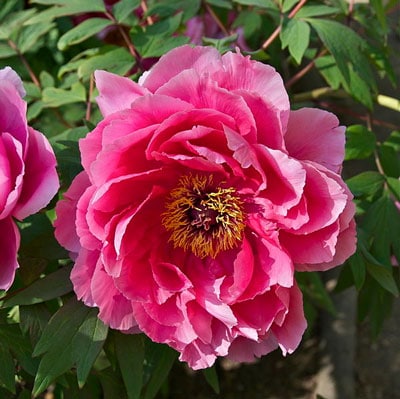Peonies – Transformed Into A Flower By Zeus To Escape The Wrath Of Asciepius
Scientific Classification
| Kingdom: | Plantae |
| (unranked): | Angiosperms |
| (unranked): | Eudicots |
| (unranked): | Core eudicots |
| Order: | Saxifragales |
| Family: | Paeoniaceae |
| Genus: | Paeonia |
The flowering plant, the peony, the lone species paeonia, belongs to the family Paeoniaceae. Peonies are natives of Asia, Western Northern America and Southern Europe. Clarity of boundaries between the species is not specific; but the approximation of the number of species varies from 25 to 40. The flower peony is named after Paeon (otherwise spelled Paean). Paeon was a student of Asciepius, the Greek god of healing and medicine. To save Paeon from the jealous eyes of Alceipius, Zeus turned Paeon into the peony flower and thus saved him from the fury of Asciepius. The flower peony thus takes its name after Paeon. Propagation of itoh and herbaceous peonies takes place through division of roots and partially through seeds.
Anatomy
The majority of the peony plants are herbs of 0.5 to 1.5 meters (1.6 to 4.9 ft) height, but others grow up to trees of 1.5 to 3 meters (4.9 to 9.8 ft) in height. They have multiple, big broad and rounded leaves, often sweet smelling. Peony flowers are yellow or red to white in color, seen in the beginning of summer and towards the end of spring.
How to cultivate Domestically

Photo by: Diego Delso
Preparation of planting
All the varieties of peonies come out in the fall as:
- Bare-root plants.
- Sometimes from the nursery bud vase.
Peonies prefer partial or full sun during the day. Heat of summer is not an issue for the plants; nevertheless, they never last for long in dry and hot spring season. In such circumstances, select a place exposed only to the morning sun.
Planting
- Plant peonies in fertile, moist and humus-free soil. Plant them deep in the soil and never allow the soil to water-log.
- Peonies prefer complete sun, though half a day’s sun is tolerable, they flower best where it is sunny.
- Choose a sunny area and dig a moderate-sized hole, approximately 2’ deep and 2’ wide, in a quick drained soil. In case the soil is very sandy or weighty, make it rich with compost.
- Supplement the soil with 1 cup of bone meal and Pack the soil firmly.
- Place the roots 2 inches beneath the soil in firm soil in such a way that the eyes look upwards.
(In the Southern states, look for early blooming species, plant them in approximately 1 inch deep in shady places)
- When filling the hole, take care not to bury the roots deeper than 2 inches.
Placement and Watering

Photo by: Jebulon
Plant the peonies prior to the first hard frost. Peonies planted in spring do not bloom well; botanists say that they bloom a year later than those planted in the fall.
The growing peonies need only limited water. They say these plants never like their roots wet. All the more, at the time of their first season, the roots do not develop in full, still you should provide them with constant watering, In summer, water thoroughly.
Flowering Period
Peonies bloom for 4 to 5 weeks. The early blooming types begin in May; those blooming in mid season, begin at the beginning of June and Peonies that bloom later blossom towards the end of June.
After Bloom Care
Take away the faded flowers immediately, cutting or picking them just beneath the base of the flower. This process is called deadheading; This is done to restrain the progress of seed growth. During seed formation, the plants absorb the food reserve and in the coming year they produce smaller flowers.
As Cut Flowers

Photo by: Diego Delso
Peonies are the glamour of the landscape of your garden. They are graceful when kept as cut flowers. Peony flowers are cut from your garden and decorated in buckets or vases. Once the peony flowers are cut from the garden, more flowers will grow in its place. You should cut the peony flowers only in the morning. Cut them only about 1/3 from the base, for ensuring regrowth.

Having discovered a fondness for insects while pursuing her degree in Biology, Randi Jones was quite bugged to know that people usually dismissed these little creatures as “creepy-crawlies”.







